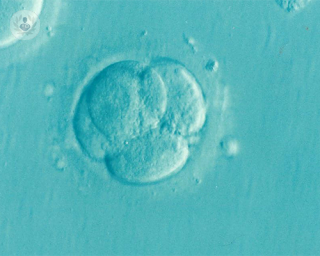Frozen embryo transfer (FET)
Mr Rafet Gazvani - Fertility specialist
Created on: 11-13-2012
Updated on: 04-17-2023
Edited by: Conor Dunworth
What is a frozen embryo transfer (FET)?
A frozen embryo transfer involves thawing and then transferring one or more embryos into a woman's uterus through the cervix using catheter.
This technique is painless and does not require any type of anaesthesia or sedation and the patient can be accompanied throughout the entire process by a partner.

Why is it done?
During an IVF cycle, more than one embryo can be made and it is usually recommended to transfer one and freeze the others. If more than one embryo is transferred at the same time, then it runs a serious risk of a multiple pregnancy. There are different phases during IVF and the embryo transfer is the last step of this assisted reproduction technique.
What does it consist of?
Embryo transfer can be done under ultrasound guidance to visualise the endometrium and deposit the embryos 1cm from the uterine fundus. Currently, most transfers are made through the cervix of the uterus. To see the cervix, a vaginal speculum is used.
As a general rule, it is performed on the fifth day, when the embryo reaches the blastocyst stage.
Embryo transfer can be carried out with embryos from the IVF process or embryos from an earlier cycle. To carry out the procedure, the woman's uterus is first prepared, the embryos are thawed to a 37 °C and transferred through a catheter to the uterus.
Preparation for embryo transfer
Although it is not necessary to fast beforehand, you must drink up to a litre of water beforehand, since the uterus is more visible with a full bladder.
Usually at the clinic, just before the embryo transfer, the selected embryos are placed in a growth or culture medium. Embryos are loaded at the end of the catheter and gently deposited inside the uterus.
After-care
Some of the recommendations made to patient after the process include:
- Rest: The recommended rest time in the clinic after the transfer is about 20-30 minutes. Once you are discharged, you can continue with your day-to-day routines however, avoiding any excessive activities.
- Avoid physical activities: walking, driving and going to work is fine, but try to avoid any exercise or strenuous activities. Practice relaxation techniques such as yoga or taichí.
- Sexual intercourse: it is recommended not to have sexual intercourse until after the pregnancy test.
- Take the right medication: the doctor will tell you which medication to take until the pregnancy test.
- Avoid baths: try not to bathe in a bath, pool or the sea in order to avoid possible infections.
- Drink water: drink the daily amount recommended by the specialist to ensure the correct functionality of the cells and prevents cell dehydration.
- Remain calm: it’s important not to be stressed. Try to remain as calm as possible.
Which specialist performs a frozen embryo transfer?
Reproductive endocrinologists can carry out a frozen embryo transfer.









